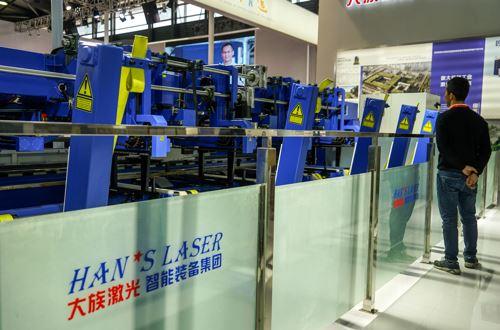
Wind Energy




Chinese scientists found that chemical compound 4-vinylanisole(4VA) is highly attractive to gregarious and scattered migratory locusts. This research is an important breakthrough in entomological field, making it possible to prevent and control locusts.

Chinese President Xi Jinping on Tuesday signed a presidential order to award epidemiologist Zhong Nanshan the Medal of the Republic, the highest state honor, for his outstanding contributions in China’s fight against the COVID-19 epidemic.
This is the second time for China to award the medal. The first was awarded last year to pharmaceutical chemist Tu Youyou, Yuan Longping, a Chinese agronomist and educator, and Shen Liangliang, a soldier of the Chinese peacekeeping force in Mali.

Along with Zhong, China’s top medical adviser Zhang Boli, top Chinese vaccine researcher Chen Wei and Zhang Dingyu, dean of Wuhan Jinyintan Hospital, were awarded national honorary titles, “the People’s Hero.”



Awarding the top honor to four prominent coronavirus fighters in China showcases the core spirit of the Chinese people in respecting science and professionalism – two key factors that helped the country win the battle against COVID-19, experts said.

The 2020 Fortune Global 500 list was released, with Walmart becoming the world’s largest company for the seventh year in a row, Sinopec remaining in second place, State Grid moving up to third, PetroChina in fourth, and Shell dropping to fifth place. seven Internet companies made the list, including Amazon, Alphabet Inc. and Facebook Inc. from the U.S., as well as China’s Jingdong Group, Alibaba Group, Tencent Holdings Ltd. and Xiaomi Group. The most striking change in this year’s rankings is the number of companies in Mainland China + Hong Kong, which reaches 124, surpassing the US (121) for the first time in history.


Han’s Laser Technology Industry Group 韩氏激光技术产业集团 said Monday on an open platform that it has received orders for lithography machines — the core equipment for chip manufacturing — with a resolution of 3-5μm, focusing on discrete devices, LED and other applications.


China announced sanctions on 11 U.S. officials Monday in response to U.S. sanctions against officials of the Hong Kong Special Administrative Region, said Chinese Foreign Ministry Spokesperson Zhao Lijian at a daily news briefing. The sanctions, effective from Monday, are applied to U.S. officials including Senators











11 US A s s h o l e s
针对美方错误行径,中方决定从即日起,对在涉港问题上表现恶劣的美国联邦参议员卢比奥 、克鲁兹、霍利、科顿、图米,联邦众议员史密斯,以及美国国家民主基金会总裁格什曼、美国国际事务民主协会总裁米德伟、美国国际共和研究所总裁特温宁、人权观察执行主席罗斯、自由之家总裁阿布拉莫维茨实施制裁。

Hubble is an astronomical telescope, but there is now a new successor to it, James Webb Space Telescope. But the James Webb Telescope is not actually made of glass, but a precious metal beryllium.
Beryllium is very important. In fact, this substance was discovered in ancient times.
Pure beryllium is highly toxic and is recognized as a super cancer causing agent.
But all the beryllium compounds in nature are non-toxic and beautiful. Well-known varieties of beryl include emerald and aquamarine, the best of them is the famous cat’s eye stone. And with changes in light intensity, the cat’s eye line in the cat’s eye stone opens.
In the early days, the scale of beryllium production was very small, until the situation improved after World War II. Global beryllium production in 2015 was only 349 tons, with the U.S. producing about 250 tons and China about 50 tons. Kazakhstan in the former Soviet Union had about 40 tons.
The mining countries are very sensitive to trade and are sale is generally not allowed. The U.S. allows only certain countries to import, resale to other countries is not allowed without U.S. consent.
During the collapse of the Soviet Union, Kazakhstan’s annual production of beryllium was between 170 and 190+tons, the second largest in the world. After the collapse of the Soviet Union, production dropped dramatically, exports mainly to China.
The density of Beryllium is similar to Magnesium and is almost two-thirds of aluminum. However, the strength of Beryllium and Tungsten is four times that of aluminum. The melting point is about 128 degrees Celsius.
Beryllium bronze spring is the key material for China’s early torpedoes shooting depth control key components.
Beryllium brushes in motors to drive the motor in high-speed electric torpedoes, this is currently the only ideal material.
In addition, in the use of laser weapons, Beryllium has property for non-visible light reflectivity 50%, ultraviolet reflectivity 55%, infrared reflectivity of 98%. And with higher density than silicon carbide, it is considered to be the most ideal material for space laser systems.
United States, Europe, Russia and other countries treat the processing technology as a state secret. They strictly prohibit the sale of its processing technology and finished products to China. China is constantly perfecting and improving the relevant technology , in order to catch up with the technology of these countries.
Hubble is still the most accurate rotor gyroscope in the world.
Beryllium is the key material of the electrostatic gyroscope. The electrostatic gyroscope is the highest precision inertial navigation equipment. China began researching it in the 1960s and only made a major breakthrough in 2005. Now China has successfully made electrostatic gyroscopes in China and uses them with an accuracy that reaches the international advanced level.
It is reported that China has recently discovered an extra-large beryllium deposit in Xinjiang, with a cumulative proven prospective reserve of 4,183 tons of beryllium ore, ranking first in the world.
China is a vast country and possesses a large amount of natural resources. The 柴达木盆地 Chaidamu Basin is known as the Treasure Basin.
It is home to 25 billion tons of pigments and more than 1.2 billion tons of oil resources. The natural gas resources are estimated to be 293.7 billion cubic meters.
However, due to geological reasons, the oil and gas exploration here is also a world-class problem.
To solve this challenge, in 2017, PetroChina set up a major project on key technologies in the Chaidamu Basin . Since then, more than 1,000 scientific and technical workers have spent 10 years and finally expanded the effective survey area of 12,000 square kilometers by 2017. Today it has guided the Qinghai oilfield to make five consecutive discoveries of over billion tons of oil. New proven oil and gas reserves of 460 million tons and gas production rose from 4.19 million tons to 7.38 million tons.
The solution to this problem has also led to the securing of China’s gas resources.
And recently it has been pointed out that China has dug up a huge amount of white gold, and it is a hundred times more expensive than oil. That is, Lithium, is currently known to be the lightest metal, but also a strategic resource, can be widely used in aerospace technology and other fields.
It is the green energy metal that can change the world in the 21st century.
China, the United States and Japan are Lithium consumption countries.
In particular, China’s consumption of Lithium accounted for 47% of the world.
Yet China has less than 30% of the lithium resources.
Recently China’s Sichuan Aba Prefecture四川阿坝州可尔因矿集区 found a mega
reserve of about 52 trillion tons of lithium. China’s lithium reserves is not to be underestimated. Japan, a large lithium consuming country is said to be able to provide extraction technology in exchange for China’s low-cost lithium ore. But China rejected it.
Since the U.S. raised tariffs on May 6, Trump’s job is to rule the country thru Twitter, President Xi, however, went to Jiangxi on business the same day. The unsuspecting onlookers are a little anxious and wondered why?
Today, the People’s Daily published an article on rare earths and everything became clear.
The People’s Daily article even uses the word “weapon of mass destruction”, to describe China’s use of rare earths to counter the US. In fact, earlier yesterday, the NDRC responded by saying this. “Jiangxi is an important province in the central part of the country, and the region of Ganzhou赣州, where Gannan赣南 is located, is part of the former 原中央苏区, which made great sacrifices for the victory of the Chinese revolution. If anyone wants to use products made from rare earths imported from us, to suppress China’s development. I don’t think the people of Gannan and China will be happy.”
To put it simply, rare earths are extremely valuable because of their scarcity and the difficulty of extracting and processing them. Not only precious, but critical. This is because rare earths are essential materials for countless highly sophisticated industries.
The rare earth Rhenium is used as on the stealth plane that dominated the battlefield, is essential raw materials for night vision thermal imaging.
It is also used in tanks and aircraft, electronic lasers, nuclear industry, and superconductors.
It’s even used in iPhones, cameras, heads, light bulbs, TVs.
There is no substitute. That’s why the U.S. said in Iraq that whoever controls the rare earths will control the battlefield.
So who has the rare earths?
China is the world’s largest supplier of rare earths.
So far, the U.S. relies entirely on imports for rare earths, and 80% is sourced from China.
That’s why there is a saying on the internet that China has 3 cards up its sleeve and the trump card is rare earths. Is this really true? In fact, no one really knows, the so-called bottom card is never reviewed because the bottom card is the last bargaining chip. There’s no back up after you’ve used it.
The cards in Trump’s hand have been showed. China’s bottom card is still in its hand. The most distressing thing about rare earth is that for 30 years before the 1990s, the world’s first power was originally the United States. 1949, the United States discovered the Mountain Pass Mine rare earth mine in California.
For a long time, the world looked to the United States for rare earths, and the United States looked to the Mountain Pass Mine for rare earths.
It was just after World War II, the U.S. economy took off, and color television sales entered thousands of homes. And color TV screens just can not do without rare earths. Molycorp, the owner of the Mountain Pass Mine made a lot of money as a result.
The wilderness mine lay profitable 30 years ago until the 1980s but suddenly the US government blackmailed.
The reason was a leaking 600,000 gallons of wastewater from the wastewater treatment pipe that evaporated in three days on the side of the highway, with radioactive material. Thorium and Radium.
The lawsuit lasted until the late 1990s, when Molycorp paid a $1.4 million fine. Although the money was a small amount, the fine made Molycorp uncomfortable.
America is not making good money anymore.
Where the money was good, China.
In the 1990s, when Bayan Obo Mining District 白云鄂博矿区 was in rare earth madness, China was cheaper than dirt, and to buy was to earn.
Molycorp also decided to open the field to Bayan Obo .
In 2002, after half a century of glory, only a green water was left in the huge pit of
Mountain Pass Mine.
Molycorp may be proud of his own business algorithm. But he didn’t realize, not even all of America, that more and more toxic companies would move from the world to China after that. A huge industrial chain will be formed.
And while the U.S. lies back and enjoys the investment returns, it gives its rare earth industry to China.
China traded the environmental cost for skilled technical research personnel.
Thirty years ago, Bayan Obo was just a market for primary ores.
Thirty years later, there is a whole industrial chain of rare earths here.
In 2010, global rare earth prices skyrocketed due to the tense situation in the Diaoyu Islands.
The two pillars of Japan’s economy, automotive electronics industry is completely inseparable from rare earths, and more than 90% of imports are from China.
It turns out that 450,000 jobs on the other side of the world, in the European Union, were affected in terms of industrial output.
Yes, everyone was in a cold sweat.
When did Chinese rare earths become so evil?
The U.S. government urgently investigated the global rare earth chain.
The results of the investigation were a shocker.
China produces 95% of the world’s rare-earth raw materials, 97% of its rare-earth oxides, and 90% of its rare-earth metal alloys.
75% such Neodymium magnet and 60% of mountain solitons.
From the mining and separation of rare earths, to the refining and refining of the oxides to magnetic materials. The US has no place in the global supply chain.
What’s that saying, when time abandon you, you don’t even say goodbye.
In 2010, the Americans turned on the eight-year-old abandoned Mountain Pass Mine rare earth mine.
The environmental pollution was still there. But the Americans couldn’t care less. Two years later, this property produced its first rare earths. An annual production of just 800 tons, compared to China’s 100,000 tons. The next year, Mountain Pass produced 4,000 tons. This is not an inspirational story, as it held up until 2015, when the owner of the rare earth mine finally went bankrupt.
Everyone realized how hard it was to rebuild the US rare earth industry.
In 2017 the Mountain Pass mine, which had been dormant for three years, was packaged for sale with an asking price of $20.5 million. This is a dirt cheap price, and if you sell a Beijing 2nd Ring apartment, you can afford to buy two rare earth mines.
One of the propective buyer is Chinese. The patriotic mine owner immediately flew to the White House to snitch to Trump.
The White House’s heart was in its throat. The first reaction was to take back the rare earth mines. The state blocked the Chinese takeover plan.
In the end Mountain Pass was owned by three companies, the Chinese owned only 10% of the shares.
Trump is so nervous because he’s been ready for a trade war for a long time and rare earths are his big weakness.
Mountain Pass is once again under construction. But alas. They have no other choice but to ship the ore to China for processing. It takes a complete industrial system to turn ore into metal, to make metal-processed magnet batteries and iPhones.
In an interview with the New York Times, the executive of Lynas Corp , the largest producer of rare earths outside China , said.
I think there are about 100 PhD’s in the technology industry that are working on applications within China and working on technology development.
Do you know how many Ph.D.s there are outside of China?
With the fingers of his right hand he made a zero.
This game of US-China trade war is in full swing.
The bottom card is not to be played, but rather to be deployed.
China’s bottom card has not yet been played, and it doesn’t want to.
The sword does not have to be unsheathed, and when it does it hurts. And how many cards are left in Trump’s hand?
8-20 China’s exports of rare earths have fallen sharply since the beginning of the year, dropping 69.1 percent in July compared with the same month a year earlier. In July, exports of rare earths were only 1,620 tons, compared to 5,243 tons a year earlier. The decrease in exports became evident after April. According to analysis, this was due to the global spread of the neo-crown epidemic, which led to a decline in foreign demand and disruptions in international logistics.
